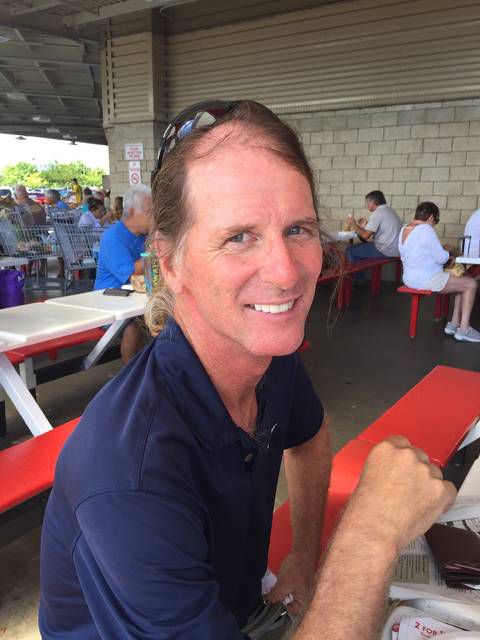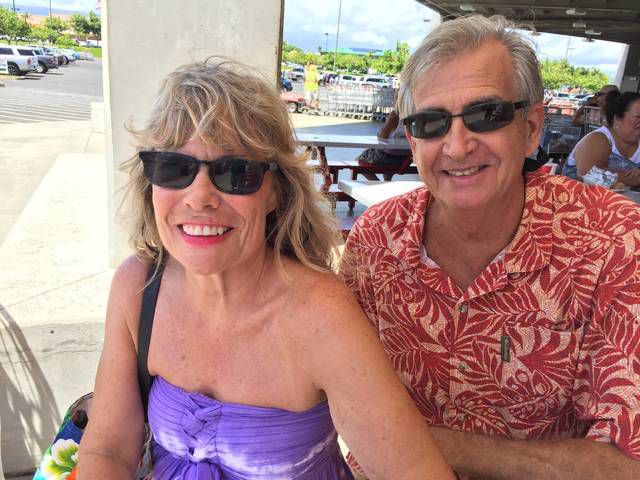LIHUE — Mostly sunny skies lit up people’s faces going about their business on Monday. With temperatures in the mid-80s and light tradewinds from the northeast in Lihue, it’s almost hard to imagine Hurricane Iniki making landfall here exactly 25
LIHUE — Mostly sunny skies lit up people’s faces going about their business on Monday.
With temperatures in the mid-80s and light tradewinds from the northeast in Lihue, it’s almost hard to imagine Hurricane Iniki making landfall here exactly 25 years ago.
“It’s always a beautiful day just about everyday here,” said Philip Proffitt of Anahola. “There’s nice people everywhere you go. That’s one thing I like about the island and what drew us to the island, the people. We appreciate the way they are just easygoing. They take time enough to talk to you.”
It’s another postcard day in paradise here, while people in Florida are dealing with the aftermath of Hurricane Irma, from flooded homes to power outages across the state. It serves as a reminder how unpredictable weather systems can change life.
Chris Suard of Wailua Houselots is fighting cancer. He treasures life here.
“I golfed this morning, and I get to help a friend get her internet up this afternoon. There’s positive things to do, and the outlook is bright,” he said. “Just 25 years ago, they couldn’t have fixed my heart and my cancer like they can now. So, advances in medicine are good. I think the satellite tracking is not a bad thing for weather either.”
Steve Thatcher owns Kauai Marine and Mower, a Kapaa business that, after Hurricane Iniki, left Thatcher swamped with work — much of it repairing generators for people who’d survived the storm.
Describing Iniki today, Thatcher — who also chairs the board of KKCR — talks about aspects of the hurricane that might seem incongruous. For example, he said he got into his car after the storm passed without realizing that the winds that tore roofs from houses also caused an islandwide rain of roofing nails.
“I got about a half block and had my first flat tire,” he recalled, noting that the island was immobilized in many ways no one ever expected.
Looking back from today, Thatcher thinks changes on Kauai include “more traffic. Though I think the population isn’t much greater, the number of visitors and their cars has increased. This could certainly provide for problem issues during another major hurricane.
Like many Kauai residents, Thatcher has been watching news coverage of hurricanes Harvey and Irma. Those two storms make island people even more aware of how in the balance Kauai was in those first days after Iniki.
“Most housing has been retrofitted or built new with hurricane standards in place, so actual structural damage during a (next) major (hurricane) may be less. But then we may have a stronger storm than Iniki. With all the disasters happening around the world, and the state of the economy and the federal budget, will the government be able to provide recovery assistance like after Iniki? Possibly not.”
Beth Tokioka, former chief of staff to Mayor Bernard Carvalho and now public affairs director for the Kauai Island Utility Cooperative, went through Iniki while she was working at a Lihue hotel 25 years ago.
She echoed remarks by others who have noticed the hardening of Kauai’s electrical grid post-Iniki. Although the publicly owned system still has scattered minor outages, Tokioka said, it is substantially better prepared for another Iniki or something like Harvey or Irma.
Ironically, she said, KIUC’s new smart meter system makes it possible to monitor the islandwide grid and respond to problems far faster than was possible at the time of Iniki.
“We’ve been able to harden our infrastructure (primarily our poles) significantly since Iniki.,” Tokioka said. “Our transmission lines are all now metal, and our wood poles are larger and supported with additional storm cables.”
Joan Conrow, who for many years wrote the definitive local political blog, Kauai Eclectic, reflected on Kauai at the time of Iniki and now, saying “Iniki prompted stronger buildings, so the island would be more resilient if another hurricane hit. On the downside, we lost a lot of picturesque iron roofs.
“On the other hand, it’s been 25 years, so we have a whole new group of people who have never gone through a hurricane and thus aren’t as likely to be prepared. There has also been more development in coastal areas — and people built again in the same places on the southside where houses got wiped out from the storm surge after Iniki.
“Overall, though, I think Kauai still is a small and caring enough community that we’d see people helping one another out like they did after Iniki.”
Jan TenBruggencate, longtime Kauai resident and former Honolulu news reporter who grew up on Molokai, recalled of Iniki: “At a very simple level, there was a real feeling of shared experience among those who had undergone the storm and then worked shoulder-to-shoulder with neighbors to rebuild.”
Iniki, he said, “was devastating. It was painful. It was physically and economically costly. But in a certain way, having gone through it together made us recognize how much we depended on each other, and made us feel like family.
“Iniki created a significant shift in the island demographic. Hurricane Iniki was so destructive that a fair number of Kauai residents moved way for work, and many of them have not returned. There were also a significant number of people who come from elsewhere, and who have remained.”
Bill Troutman, Kilauea resident and fixture of the town and many of its volunteer assistance organizations, had worked in construction for three years before Iniki hit. Today, he is heavily involved in Red Cross and Lions Club. He looks at what’s happened with Harvey and Irma and wonders if Kauai really is ready for a next hurricane.
“My one big concern for the North Shore is lack of shelters during a storm. During Iniki, the Princeville Hotel (now the St. Regis) opened to all and many places opened, even Kilauea Gym, which lost its roof with over 300 people inside.
“Princeville visitor accommodations recommend now that visitors pack up and go to shelters, but the Kilauea Neighborhood Center (for example) can only shelter 125 people. If Iniki were to happen today, two hours before contact Kilauea would be grid locked with visitors trying, and not being able, to get to Kilauea Neighborhood Center.
Diana Terrazas had been on Kauai before Iniki, moved back before the hurricane and then returned in 1993. She lives in Kilauea and bore four daughters after the hurricane — the younger two of whom are students at Kapaa High School.
Terrazas said she’s concerned the island’s infrastructure has not kept up and could create real problems in the event of another hurricane.
“These roads (and lack of) are terrible and just dangerous,” she said. “And something like an additional 20,000 people have moved to Kauai in the past 25 years.”
Valerie Ann Begas, a resident of Lihue since 1981, expressed appreciation for life on Kauai.
“Well, I’m glad we don’t have a hurricane now,” she said. “Iniki was a lesson, and I just pray we don’t have any more. The island was a mess.”
Many residents can relate to the impacts of the severe tropical system affecting the other side of the nation, even if it was occurring nearly 5,000 miles away.
Some were buying water and nonperishable goods Monday to be prepared for emergencies.
“Just having a beautiful day here in Hawaii again, it’s another great day in paradise,” said Mario Ragsdale of Lawai Valley. “It’s definitely still in the back of the mind. There are a lot of people that are suffering. Even going to the store and donating when I can definitely helps. Because if we were in the same situation or the roles were reversed, people would be helping us.”



